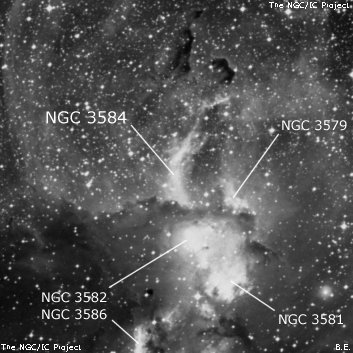
John Herschel discovered NGC 3584 = h3329 on 16 Mar 1834 in a complex of emission nebulae and recorded "L, bM, E in meridian. Place by collation of diagram."
Joseph Turner sketched the complex on 19 May 1876 with the 48" Great Melbourne Telescope (plate IV.35 at www.docdb.net/history/texts/1885osngmt________e/lithograph_m_4_35.php), and NGC 3584 is shown as a looping nebulosity, narrowing on the north end and matching my description and the photographic appearance.
400/500mm - 18" (7/7/02 - Magellan Observatory, Australia): NGC 3584 is the furthest northeast and the largest section of nebulosity. It appears as a looping arc about 3.5'x1', bowed out towards the east and extending mostly N-S and narrowing at the north end. A few mag 12 stars are off the edges. NGC 3579 appears as nearly a continuation of this loop towards the west.
Notes by Steve Gottlieb